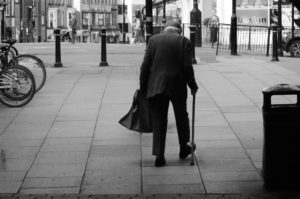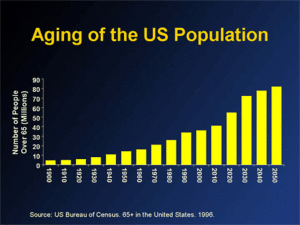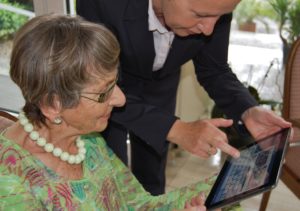
Imagine that you are retired and living alone in a small apartment on the outskirts of the city. Your income, either from Social Security, a pension, or disability payments is fixed. What is left over after the rent and utilities are paid hardly covers any food, much less nutritious foods. Most of your friends have passed away or moved. You don’t have a car. On many days, you sit in your kitchen, hungry and alone.
A growing segment of the population
Out of the 50 million Americans that are currently food insecure, seniors, for the first time ever, account for more than 10 million. Due to the Great Recession of 2007, the at risk senior population has more than doubled since 2001 and with the last of the baby boomers reaching retirement age in the next ten years, reports expect their numbers to double by 2040.

Over 10,000 people will turn 65 each day until 2030, making seniors, the fastest growing segment in the U.S. population.
The Numbers
The National Foundation to End Senior Hunger (NFESH) released the following findings in their study titled the State of Senior Hunger in America 2014:
- 15.8% of seniors face the threat of hunger. This translates into 10.2 million seniors.
- Those living in states in the South and Southwest, those who are racial or ethnic minorities, those with lower incomes, and those who are younger (ages 60-69) are most likely to be threatened by hunger.
- Out of those seniors who face the threat of hunger, the majority have incomes above the poverty line and are white.
WHY SENIOR HUNGER?
Many younger Americans are forced to seek short term food aid due to a recent personal economic setback. They’ve lost their job, or have had an accident where they cannot work. For them, food insecurity is a temporary condition until they find a new job, or recover from injuries and return to work.
Unlike many of their younger food insecure counterparts, the seniors’ prime income earning years are behind them. The elderly and specifically the elderly at or below the poverty level, live on fixed incomes from Social Security, pensions, or disability payments. Any economic upturn will only affect them in terms of cost of living increases to those programs so they are especially sensitive to increases in housing, medical, and food costs.

Many of the lower income seniors rent and according to Stan Humphries, Chief Economist at Zillow, “Since 2000, rents have grown roughly twice as fast as wages, and you don’t have to be an economist to understand why that is hugely problematic. While renters have historically spent about a quarter of their income on housing costs on average, they can now expect to spend about 30%.” With more money going to rent, it leaves less for medical & food costs.
Plain and simple, seniors need more and spend more for medical care. Feeding America which runs over 200 food banks and serves over 60,000 food pantries nationwide, reports that in client households with at least one senior, 47 percent report that a household member has diabetes and 77 percent report that a household member has high blood pressure. The medicines needed to control these conditions are expensive even if the individual has insurance and just settles the co-pays.
The 2004 National Health Expenditure Survey found that seniors spend more per capita on out-of-pocket healthcare expenses than any other age group. Seniors age 65 and over spent an average of $4,888 per capita annually out of pocket for deductibles, co-payments, premiums and other health care expenses not covered by insurance, more than twice as high as the average non-elderly adult. The result is often that seniors must make a choice between the medicines that they need and food for the table. A common compromise is buying low cost processed food that will sustain them, but that choice comes with a price.
Many of the processed foods, which they buy for the convenience of storing for months in their pantry at home, are much higher in salt, which contributes to high blood pressure, and sugars which leads to diabetes. This often results in a vicious cycle of taking expensive medicines to control a condition, and eating foods that perpetuate a condition.
In addition, many seniors are simply not as mobile as they used to be – they are just frailer, battling a health condition or just unable to drive any more. This affects their access to fresh, nutritious foods on a regular basis.
Even those seniors who are comfortable in their retirement are affected by the costs for nutritious fresh produce – which have increased more than 40% since 2000.
An Issue of Nutrition
The nutritional intake level needed to remain healthy is higher for seniors than for those who are younger. Their slower metabolism means a lower but nutrient rich caloric intake is in order. Unfortunately, as people age they commonly desire more easy to chew and digest comfort foods, which are heavy in starches. They tend to avoid fresh fruits and vegetables which would provide needed nutrients.
“In part because of lower and inadequate nutrient intakes, food insecure older adults and seniors, especially those with poor health, can experience declines in health.” RTI Full Hunger Report
Seniors, if they are not getting nutritious food, are especially susceptible to health issues such as diabetes and heart disease. Food insecure seniors are twice as likely to be diabetic and are 53% more likely to report a heart attack than their food secure counterparts.
High salt and fat levels in many processed foods, combined with a lack of exercise lead many seniors to higher instances of high blood pressure and cholesterol levels. The medications needed to control these health problems drains an already limited income leading to a vicious cycle of being only able to afford calorie dense but nutrient light foods – resulting in more health issues and more medication.
Help with Getting Help
Getting help to the senior population is problematic. There is a general lack of knowledge of the programs available and many do not believe in what they would call “handouts.”
“The senior population has, I think, a stigma of food stamps that’s stronger than it is with other demographic groups – probably because they grew up with a different notion of food stamps. They view it as welfare.” Jeff Klein, executive director of Sound Outreach
As a percentage of the total population, the elderly are far less likely to register for social programs that would benefit them. Only one third of seniors that are eligible for food programs such as the Supplemental Nutrition Assistance Program (SNAP) or the Senior Farmers’ Market Nutrition Program (SFMNP) actually apply for them. They are not always aware of the programs available, or would feel stigmatized by having to apply for them.
For a generation that did not grow up with the internet, registering online for assistance is not an option. Some live in retirement homes and do not venture out often, some are disabled and cannot get to the local SNAP offices.

In a world increasingly driven by technology, it is easy for seniors to feel left out. Advancements in online registration for programs are not as effective with the senior population.
Senior hunger is not always limited to the low income areas of major cities. In the ritzy retirement city of Naples, FL, census data recently showed pockets of poverty that were previously unknown. This prompted local food banks to mount an outreach program to educate those retirees living in gated communities about the availability of programs like SNAP, Meals on Wheels, and food pantries.
For those seniors who are not mobile, many of the food distribution organizations have changed their approach – as in the case of the Maryland Food Bank’s My Groceries to Go program, which boxes up food and delivers it to senior centers.
As more and more Americans reach their 60’s and 70’s the food system will continue to become more adaptive to their particular needs. Grocery stores continue to experiment with larger – easy to read signage, placement of the most commonly bought items within easy reach while avoiding placement of heavier grocery items too low. All of this to accommodate an increasingly large segment of the US population.
WAYS TO HELP
September is Hunger Action Month and while senior hunger remains a severe and challenging problem there is so much that each of us can do to help.
- Donate to the AARP’s annual Virtual food drive to help seniors
- Donate to your time or money to Meals on Wheels or Catholic Charities which can often deliver nutritious meals to the elderly
- Volunteer or donate to the senior center in your town
- Educate your senior friends on the various programs available and register them using the AARP Benefits Quicklink
- Let your Congressman and Senator know that you support food assistance for the elderly.
- Click here to:
- Find your Congressman
- Find your Senator
Any hunger – child hunger, adult hunger or senior hunger – is unacceptable in the richest country in the world. Let’s end this.
